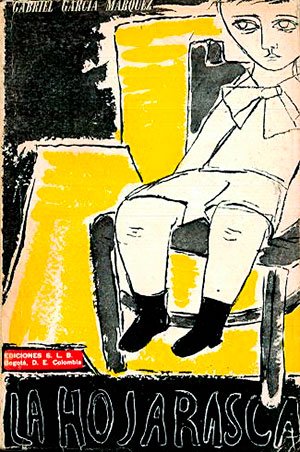
Bibliographic data

- Author: Gabriel García Márquez
- Title: Leaf Storm
- Original Title: La hojarasca
- Year: 1955
- Published by: Ediciones S.L.B.
- Country: Colombia
- Genre: Novel
- Pages: 137
Synopsis of “Leaf Storm”
In the mythical town of Macondo, a recurring setting in the works of Gabriel García Márquez, the community is shaken by the mysterious suicide of a doctor, a man ostracized by the townsfolk for unknown reasons. Despite the town’s widespread aversion to the deceased, a family consisting of a retired colonel, his daughter Isabel, and his grandson, decides to take on the responsibility of giving him a proper burial.
The story unfolds through the memories and reflections of these three characters, who, from different perspectives and timelines, offer a glimpse into the intricate web of relationships, secrets, and tensions that underpin Macondo’s history. The leaf storm, a constant motif in the novel, doesn’t only refer to the dry leaves falling from trees but symbolizes the weight of the past, traditions, and memories accumulating in the town.
With his characteristic magical realism style, García Márquez weaves a narrative exploring universal themes such as memory, ostracism, morality, and the quest for redemption. “Leaf Storm” delves into how past decisions can influence the present and how, in the face of prejudice and disagreement, compassion and humanity can prevail.
Spoiler Alert
Summary of “Leaf Storm”
“Leaf Storm” is a novel written by the Colombian author Gabriel García Márquez, first published in 1955. This work is essential for understanding the author’s literary universe and is considered by many as the inception of magical realism in his writing.
Plot:
The story of “Leaf Storm” is set in the mythical town of Macondo, a recurring backdrop in García Márquez’s works. The plot revolves around the mysterious suicide of an unnamed doctor who, for reasons unveiled as the story progresses, is shunned and rejected by the Macondo community. Despite this widespread disdain, a family, comprised of a retired colonel, his daughter Isabel, and his grandson, chooses to bear the responsibility of giving him a dignified burial.
The narration is structured through the viewpoints of these three characters, who at different timelines recall and reflect upon the events leading to the doctor’s tragic end. These memories, intertwined with the present, slowly uncover the complex web of relationships, betrayals, loves, and animosities that shape the history of Macondo and its inhabitants.
As the tale progresses, we learn that the doctor had come to Macondo fleeing a tumultuous past, seeking a fresh start. However, his interactions with certain townspeople and his involvement in pivotal events in Macondo’s history render him an outcast. His relationship with the colonel’s family is especially poignant, as despite tensions and disagreements, there lies a bond of mutual respect and gratitude.
The doctor, in his quest for redemption and acceptance, gets ensnared in a series of conflicts that unveil the underlying tensions in Macondo. These conflicts, ranging from political disputes to personal feuds, mirror a society grappling to define its identity amidst a rapidly changing world.
The doctor’s climax, his choice to end his life, emerges as a symbolic act challenging the community’s values and morality. The colonel’s family’s decision to oversee his burial, defying the town’s will, stands as a powerful statement of humanity and compassion amidst indifference and prejudice.
Through this intricate narrative, García Márquez crafts a profound meditation on the essence of ostracism, collective memory, and the human capability for redemption and finding purpose amidst adversity.
Setting Description:
Macondo is a town that could be situated anywhere in Latin America but carries distinct characteristics of Colombia’s Caribbean region. It’s a place where the real and the magical coexist naturally. The “leaf storm,” which titles the novel, doesn’t just refer to dry leaves falling from trees, but symbolizes the accumulating past, upheld traditions, and guarded secrets.
The atmosphere in “Leaf Storm” is oppressive and melancholic. The constant wind and invading leaf storm reflect the residents’ mood and the air thick with memories and grudges.
Main Characters in “Leaf Storm”
1. The Colonel: A man of steadfast principles, a veteran of multiple wars, and deeply rooted in his sense of duty. Despite the town’s animosity towards the doctor, the colonel chooses to honor his memory, sharing a history with him.
2. Isabel: The colonel’s daughter, she is caught between her reverence for her father and love for her son. Her memories reveal many of Macondo’s mysteries and her own family’s secrets.
3. The Grandson: Through his innocent eyes, a fresh and different perspective on the events is presented. His curiosity about understanding his grandfather’s and mother’s actions leads him to uncover the darkest secrets of his family and Macondo.
4. The Doctor: Although dead from the novel’s start, his presence is omnipotent. Through the memories of other characters, a portrait of this outcast man is painted, somehow connected to everyone.
Analysis of “Leaf Storm”
“Leaf Storm” stands at a pivotal moment in Latin American literature. It heralds the dawn of magical realism, a style García Márquez would refine in later works like “One Hundred Years of Solitude.”
The novel is notable for its innovative narrative structure, where time isn’t linear, and memories intertwine with the present. This technique lets García Márquez probe into Macondo and its inhabitants’ collective memory and how it influences their actions and choices.
Among García Márquez’s works, “Leaf Storm” holds a special place. Though not his most famed novel, it lays the groundwork for the literary universe he’d craft in subsequent works. Macondo, with its blend of reality and magic, becomes the perfect stage to probe universal themes like memory, death, love, and solitude.
Regarding its significance, “Leaf Storm” breaks the literary conventions of its time and prefigures many traits that would later make García Márquez famous. Though brief, the novel provides a deep introspection into human nature and how the past impacts our present.
“Leaf Storm” is pivotal for understanding Gabriel García Márquez’s literary universe. Through its magical ambiance and multifaceted characters, the novel offers a profound, melancholic view of memory, the past, and the human condition. It invites reflection on how memories and secrets can shape our choices and perception of reality.
Esta versión del texto corrige la ortografía, mejora la redacción y garantiza una gramática más precisa.





